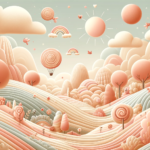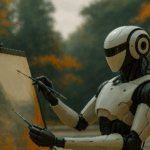“Art is not a mirror held up to reality, but a hammer with which to shape it.” Bertolt Brecht
Art Meets Algorithm: Creativity in the Age of AI
When machines paint, humans rethink what art really means
The Brush and the Bot
From canvas to code, art keeps evolving
Art has always panicked in the face of new technology. The camera was supposed to kill painting. The printing press, critics feared, would cheapen literature. Now AI is the new villain or savior, depending on which gallery you’re in.
In 2024, AI image tools like MidJourney, DALL·E, and Stable Diffusion became both toys and threats. With a single prompt, anyone could conjure a “Baroque portrait of Beyoncé surfing on Saturn.” The results ranged from uncanny beauty to meme fodder, but the shock was the same: creativity no longer required brushstrokes, just keystrokes.
The panic is familiar, but so is the possibility. As history shows, every technological disruption in art doesn’t kill creativity it mutates it.
Machines Have Muses Too
Algorithms remix the ghosts of artists past
AI doesn’t dream, but it certainly digests. These systems are trained on oceans of data artworks, photographs, text and then spit out uncanny hybrids. That’s less divine inspiration, more remix culture on steroids.
The philosopher Roland Barthes once declared “the death of the author.” In AI art, the author is not just dead but distributed. A single image might carry whispers of Basquiat, a dash of Pollock, and a hint of Tumblr fan art. Originality looks suspiciously like aggregation.
And yet, there’s something undeniably creative about recombination. Brian Eno called art “the act of creating beautiful things you hadn’t anticipated.” If unpredictability is a creative virtue, AI might be a worthy collaborator if not a particularly soulful one.
The Labor Question
Whose brush is it, anyway?
While art critics debate aesthetics, artists themselves have raised a more pressing issue: consent. In early 2024, lawsuits piled up against AI companies accused of “data laundering” scraping millions of artworks without permission. The complaint is simple: when an AI mimics a living artist’s style, shouldn’t the artist be paid?
Concept artists and illustrators, many already navigating the shaky economics of freelance work, see AI as a threat to their rent, not just their reputations. The fight isn’t just about intellectual property it’s about labor, survival, and the right to control one’s own creative fingerprint.
It’s worth remembering: every technological revolution disrupts jobs before it stabilizes them. Photography displaced portrait painters. Desktop publishing rattled typesetters. Now generative AI looms over digital creatives. The difference is scaleand speed.
Collaboration or Colonization?
The future of art is duet, not duel.
Not all artists see AI as an enemy. In 2024, Refik Anadol’s data-driven installations drew crowds at MoMA and beyond. His work turns algorithmic patterns into immersive dreamscapes that feel alive, even sublime. Holly Herndon, the experimental musician, created “Holly+,” an AI-trained version of her own voice essentially collaborating with herself across realities.
These artists flip the script: AI isn’t replacing human vision; it’s extending it. Instead of fearing colonization by code, they treat AI as a tool for scale, variation, and experimentation. Think of it as Photoshop’s rebellious younger cousin: sometimes unpredictable, but often revelatory.
The danger isn’t the tool it’s how we use it. A hammer can build or destroy. An algorithm can amplify creativity or commodify it. The choice lies with us.
Redefining What Counts as Art
If anyone can make it, does it still matter?
The deepest anxiety about AI art isn’t about jobs or style theft. It’s about meaning. When a text prompt can create a gallery-worthy image in seconds, does the concept of artistic genius collapse?
History again offers perspective. Duchamp placed a urinal in a gallery and called it art. Warhol mass-produced soup cans. The point wasn’t the object it was the idea. AI art continues that lineage: it forces us to ask not “how was this made?” but “why does it exist?”
Perhaps that’s the new frontier. In 2024, the value of art shifted less toward execution and more toward intention. Anyone can generate an image, but not everyone can tell a story that resonates. That part, at least, remains stubbornly human.
Reading List: For the Algorithmically Curious
Essential texts to make sense of creativity in the machine age.
- Brian Eno – A Year with Swollen Appendices: “Unpredictability is a feature, not a bug.”
- Hito Steyerl – Duty Free Art: “Digital reproduction reshapes not just images but power itself.”
- Roland Barthes – The Death of the Author: “Meaning belongs to the reader, not the creator.”
- Refik Anadol – Machine Hallucinations: “Data isn’t cold it can dream in color.”
- Walter Benjamin – The Work of Art in the Age of Mechanical Reproduction: “Technology changes not just art but our aura of experiencing it.”
Final Thought
When machines create, humans must curate.
AI art doesn’t mark the end of creativity. It marks the end of assuming creativity was ours alone. The machine can generate, remix, and surprise but it can’t decide what matters. That decision remains human, and perhaps that’s where the real artistry lies.
In 2024, the challenge wasn’t whether AI could make art. It was whether we could learn to see art differently.
References
- Refik Anadol (2024): Machine Hallucinations. MoMA Exhibition
- Barthes, Roland (1967): The Death of the Author
- Benjamin, Walter (1935): The Work of Art in the Age of Mechanical Reproduction
- Brecht, Bertolt (1963): Schriften zum Theater
- Eno, Brian (1996): A Year with Swollen Appendices
- Herndon, Holly (2024): Holly+ Project
- Steyerl, Hito (2017): Duty Free Art




